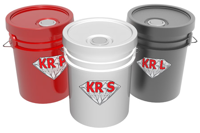| Chemical
|
Product
PN
|
Description
|
Price
|
|
Pro Shine KR Potassium (P)
& Sodium (S) - Both are single component, water-based siliconate (water
repellent and impregnating sealer).
Their differences are highlighted.
|

PRO SHINE DESENSIFIERS
- Sodium Silicate -
- Lithium Silicate -
- Potassium Silicate - Single component water-based
desensifiers to harden and strengthen cement and concrete substrates and
surfaces, providing maximum penetration for maximum surface hardness.
Difference in Chemicals? Which
One To Use?
|
|
Densifying
Concrete - Why it is important?
With the development of polished concrete there
have been a number of new products introduced to assist contractors in the
polishing process. The most significant development has been the
introduction of concrete densifiers.
While there are a large number of concrete
densifiers available on the market today, they can be grouped into three (3)
types: Sodium silicate, lithium silicate and potassium silicate.
The densifying process helps seal masonry, concrete
and other Portland cement based materials into a mass that is solid, rather than
porous. Its penetrating quality provides deep sealing that is effective
for the life of the concrete. The chemical composition or action of a
densifier creates a surface that is easy to clean and
maintain. This is done by hardening and strengthening the concrete to
protect it from deterioration which includes scratching, scuffing and dusting.
Dusting is the process
where the concrete surface begins to wear and deteriorate by the fine dust
particles. Without a densifier application the
polished concrete surface wears away and exposes the unpolished surface
below. The primary purpose for applying a densifier to a polished concrete
surface is to prevent this from occurring.
Concrete Densifiers or Hardeners - How Do
They Work?
All densifiers work in the same way in terms of
the chemical reaction that occurs and the final composition of the surface.
You
will notice that all densifiers are a type of silicate compound. The silicate is what actually changes the surface
composition of the concrete and the sodium, lithium and potassium are the transport agents for
the silicate. The densifier reacts with the free calcium carbonate in the
concrete to create a crystalline structure in the surface pores of the concrete
referred to as calcium silicate. The calcium silicate structure in the pores of
the concrete is what increases the strength of the surface. The transport
agents do not have any
impact on the surface characteristics of the concrete.
- Sodium Silicates - are applied by flooding
the surface with the densifier at a rate of approx. 200 sq. ft./gallon and
agitating the product with a broom or low speed scrubbing machine. You then
wait, allowing the densifier to completely react with the surface of the
concrete, and then thoroughly rinse the surface to remove any excess
product. Rinsing is an important step in the process because if any
excess is left on the surface it can lead to ASR (Alkali Silicate Reaction
- mass cracking on the concrete surface.) When applied and rinsed
properly this is not a concern.
- Lithium & Potassium Silicates - are applied
by using a low pressure sprayer at a rate of approx. 500 sq.
ft./gallon. They are left on the surface with no
rinsing is required. These products are generally quite a bit more expensive on a
per gallon basis but when applied at the rates suggested by manufacturers they
tend to be comparable in price to the sodium silicates on a price per square
foot basis.
Which is Better?
Lithium and potassium densifiers are
substantially easier to apply and itís no surprise that most polishing
contractors use these types over the sodium silicates. There is no rinsing or
surface agitation required and therefore it creates far less work for the
polishing contractor. Lithium and potassium densifiers are advertise as having
increased penetration over the sodium silicates and claim to have a more evenly
distributed surface densification. Some lithium and potassium densifiers only
increase abrasion resistance of a concrete floor by 20-80% depending on the
manufacturer. The penetration of the densifier is irrelevant to some extent as
the polished surface you are attempting to maintain is less than 1/64th of an
inch. While some densifiers penetrate well over 1/64th of an inch (used on
roads and highways to guard against rock salt damage) their abrasion resistance
increases to approximately 40-80%. When considering a polished concrete floor, the 5-10%
difference in the overall price of the floor is negligible when taking into
account the increased abrasion resistance of the more expensive densifier.
Sealers - Topical Sealers
All polished concrete densifyers are
penetrating. They penetrate the surface of the concrete and have no topical
characteristics. No other type of surface forming sealer should be used in
conjunction with concrete polishing. The shine from concrete polishing is
achieved through a process similar to polishing granite or slate, which is why
the shine can last decades or more. When a topical sealer is applied to achieve
shine, the shine will only last as long as the sealer. Depending on
traffic,
that may be anywhere from 3 months to just a few years.












